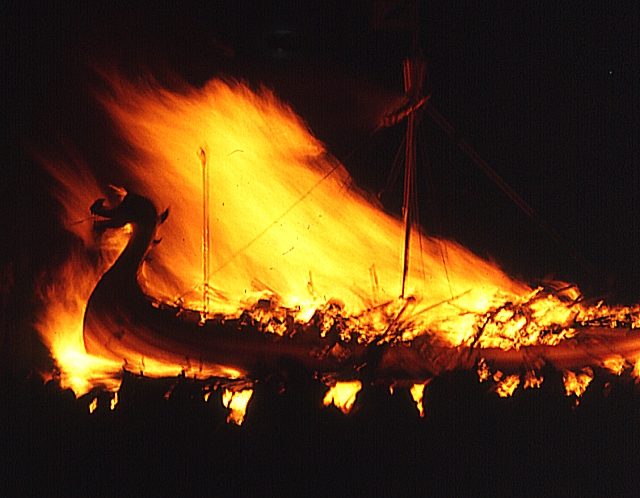In the early years of Northern Europe following the collapse of the Roman Empire, Scandinavians began raids on countries such as England, Ireland, Iceland, and into the Islamic States. Called Vikings due to their raiding strategies to enlarge the Scandinavian territories, they were involved in farming, fishing, and trade.
The name Viking is from Vikr, or “one who raids”, in Old Norse. They excelled in boat building which allowed them to expand their settlements to other countries. They began raids in England about 798 A.D. Their interest in trade revealed riches in these other lands that tempted the Vikings. After an invasion, they often proceeded to bury their booty, examples of which are still being discovered today around Northern Europe. The most recent discovery of these hoards was found in 2014 in Dumfriesshire, Scotland, known as the Dumfriesshire Hoard. Hundreds of items made from gold and silver were discovered, including jewelry, ingots and a Christian cross. The Cuerdale Hoard, found near Preston, Lancashire in 1840, consisted of over eight thousand items, mostly silver coins and bullion. Why their plundered treasure was buried and never retrieved is a mystery.

Early Viking settlements have been found in Norway, Sweden, and Denmark. They moved out to Greenland and Iceland but found farming too difficult there. Rejecting advice from the locals, they decided to move on to England, Ireland and as far as the Islamic cultures. At the time most of Northern Europe was unorganized. The Holy Roman Empire was coming apart, there was virtually no political stability in Ireland and Constantinople was at war with the Arabs. Vikings took advantage of the situation, claiming land and taking over towns.
As Viking settlements grew, the raids became more frequent, and by 865 a fleet of hundreds of Scandinavian ships called The Great Army was invading most of the British Isles. By 959 the Vikings were mixing into the English population, but new attacks were strengthening Norse control over the area. King Cnut, born in 990 in Denmark, led a Danish army to attack England causing fighting that went on for over fourteen months. He subsequently took over the throne and ruled England, Denmark, and Norway until 1035. In 1030 Harald Hardrada fought against the armies of King Cnut in an attempt to regain the throne of Norway but was defeated and sent to Kievan Rus’, now part of Russia. He spent some time in the army of Grand Prince Yaroslav the Wise, rising to the rank of Captain. In 1034, he moved on to Constantinople, eventually rising to become a commander of the Byzantine Varangian Guard. While he served in Russia and Constantinople, he managed to accrue a sizeable fortune which he sent to Kievan Rus’. When he had acquired enough military knowledge and wealth, he returned and set out to reclaim the throne of Norway.
During his reign, he established a sustainable economy and trade with other countries. Although he led raids on Denmark for years, he was never able to claim the Danish throne. In 1066 the former Earl of Northumbria, Tostig Godwinson, encouraged Hardrada to make a claim to England’s throne.
While he was successful in defeating the forces at the Battle of Fulford near York, he was killed in the same year in the Battle of Stamford Bridge. Hardrada’s death is considered to be the end of the Viking Age.
The legacy of the Vikings can be found all over Europe. Not only artifacts and buried hoards but in place names, language, and even the DNA of the residents. The towns of Grimsby and Thurnby in England are both Scandinavian names because of the ‘by’ ending of the names, meaning farm or village. Sixty percent of the surnames in York have some reference to Scandinavian influence, and words such as husband, give, and anger all originated as Scandinavian words. Normandy, France, also has many place names showing Viking influence.

The French suffix londe originates from the Norse word lund for wood, About Education reported.
Read another story from us: The era of the Norse Vikings and where it all began
The concept of a ruling parliament and to some degree the democratic process was created by the Vikings. Although the absolute rule of royalty suspended parliament for a time, it was eventually returned to English law and is still the governmental body of the United Kingdom.
